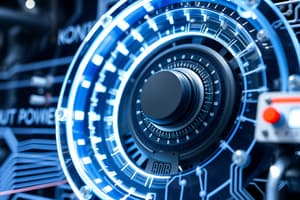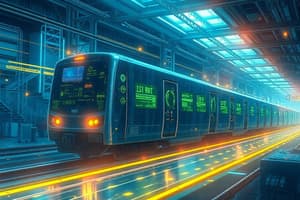Podcast
Questions and Answers
What type of control system leverages a feedback loop to adjust its output?
What type of control system leverages a feedback loop to adjust its output?
- Open-loop control system
- Man-made control system
- Closed-loop control system (correct)
- Natural control system
Which of the following is an example of an open-loop control system?
Which of the following is an example of an open-loop control system?
- A self-driving car
- An autopilot system in an aircraft
- Cruise control in a car
- A clock (correct)
- Thermostat in a house
In a closed-loop control system, what is the primary purpose of the feedback?
In a closed-loop control system, what is the primary purpose of the feedback?
- To provide a constant output
- To simplify the system design
- To measure and compare the actual output to the desired response (correct)
- To isolate the system from external disturbances
Which of these control systems is typically used in applications where error handling is not critical?
Which of these control systems is typically used in applications where error handling is not critical?
What kind of control system is best suited for handling unpredictable disturbances effectively?
What kind of control system is best suited for handling unpredictable disturbances effectively?
Which characteristic is commonly associated with open-loop control systems?
Which characteristic is commonly associated with open-loop control systems?
What is a common example of a man-made control system?
What is a common example of a man-made control system?
Which of the following is NOT a characteristic of a closed-loop control system?
Which of the following is NOT a characteristic of a closed-loop control system?
What is the primary function of a control system's integral component?
What is the primary function of a control system's integral component?
Which of the following is NOT considered a benefit of a closed-loop control system?
Which of the following is NOT considered a benefit of a closed-loop control system?
In the context of control system analysis, what is the primary objective of a 'transient response'?
In the context of control system analysis, what is the primary objective of a 'transient response'?
Why is a control system's proportional component considered to be 'quick'?
Why is a control system's proportional component considered to be 'quick'?
Which of these is a primary responsibility of a control engineer?
Which of these is a primary responsibility of a control engineer?
What does the term 'steady state response' refer to in control systems?
What does the term 'steady state response' refer to in control systems?
Which component of a PID controller is primarily responsible for predicting future errors?
Which component of a PID controller is primarily responsible for predicting future errors?
In a room temperature control system, which component acts as the 'Correction Unit'?
In a room temperature control system, which component acts as the 'Correction Unit'?
What is the primary advantage of using a PID controller over a simpler proportional controller?
What is the primary advantage of using a PID controller over a simpler proportional controller?
Which of the following is NOT a key component of a control system?
Which of the following is NOT a key component of a control system?
In a PID control system, which term is responsible for minimizing steady-state error?
In a PID control system, which term is responsible for minimizing steady-state error?
What is the primary function of a Derivative (D) term in a PID controller?
What is the primary function of a Derivative (D) term in a PID controller?
What is a 'transient response' in a control system?
What is a 'transient response' in a control system?
Which of the following is a key factor in determining the stability of a control system?
Which of the following is a key factor in determining the stability of a control system?
Which of the following best describes the purpose of implementing control systems?
Which of the following best describes the purpose of implementing control systems?
Which of the following is NOT an advantage of implementing closed-loop control systems?
Which of the following is NOT an advantage of implementing closed-loop control systems?
Flashcards
Control Systems
Control Systems
Systems that manage, command, or regulate behavior of other systems.
Closed-loop control system
Closed-loop control system
A control system that feeds back output to adjust input.
Open-loop control system
Open-loop control system
A control system that does not utilize feedback from output to input.
Open-loop System
Open-loop System
Signup and view all the flashcards
Natural control systems
Natural control systems
Signup and view all the flashcards
Closed-loop System
Closed-loop System
Signup and view all the flashcards
PID Control
PID Control
Signup and view all the flashcards
Man-made control systems
Man-made control systems
Signup and view all the flashcards
Combinational control systems
Combinational control systems
Signup and view all the flashcards
Proportional Control
Proportional Control
Signup and view all the flashcards
Integral Control
Integral Control
Signup and view all the flashcards
Open-loop configuration characteristics
Open-loop configuration characteristics
Signup and view all the flashcards
Differential Control
Differential Control
Signup and view all the flashcards
Closed-loop configuration characteristics
Closed-loop configuration characteristics
Signup and view all the flashcards
Advantages of open-loop systems
Advantages of open-loop systems
Signup and view all the flashcards
Transient Response
Transient Response
Signup and view all the flashcards
Controlled Variable
Controlled Variable
Signup and view all the flashcards
Reference Value
Reference Value
Signup and view all the flashcards
Comparison Element
Comparison Element
Signup and view all the flashcards
Error Signal
Error Signal
Signup and view all the flashcards
Control Unit
Control Unit
Signup and view all the flashcards
Correction Unit
Correction Unit
Signup and view all the flashcards
Steady State Response
Steady State Response
Signup and view all the flashcards
Study Notes
Chapter 1: Introduction to Control Systems
- This chapter covers control of machines (CMH316B) for Bachelor of Engineering Technology in Mechanical Engineering, Year 3.
- The chapter content contributes 50% to Semester Test 1 and 30% to the final examination.
- All outcomes are found in section D4.5 of the study guide.
- Each slide describes and addresses the outcomes of the study guide.
Intro: Fundamentals of Control Systems
- Outcomes:
- Understanding the scope and importance of control systems in engineering.
- Explaining the fundamentals of control systems.
- Understanding the development and purpose of control systems.
- Key Points:
- Control systems are used in engineering to command, dominate, and test/verify systems.
- Control systems are pervasive, encompassing simple to advanced physical and non-physical systems. This includes automatic control systems.
- Control systems are essential in various engineering disciplines, including mechatronics , micro and nano systems, process control, cybernetics, wireless communication, and big data and IoT.
- What is Control?
- Exercising restraint or direction over something, dominating, or commanding.
- Testing or verifying scientific experiments through parallel or comparison experiments.
Intro: Definition of Control System
- Outcomes:
- Defining control systems.
- Recognizing their significance in engineering fields.
- Recognizing control types in everyday life.
- Knowing relevant terminology and solving problems.
- Description of a System:
- A system is a set of interacting or interdependent components forming an integrated whole.
- Systems have a structure with related parts, behavior involving processes transforming inputs (material, energy, or data) into outputs, and interconnectivity where parts and processes connect with structural and behavioral relationships.
- Control Systems Defined:
- Used to regulate the behavior of devices or systems.
- Improve industrial process efficiency and safety.
- Examples exist in various industries.
- Control systems are integral in many areas of modern society.
Intro: Types of Control Systems
- Outcomes:
- Differentiating between open-loop and closed-loop control systems.
- Recognizing and comparing different types of control systems in daily life.
- Open-loop Systems:
- Output is not fed back for comparison or correction
- Effective in situations with no error management necessary (e.g., natural systems, some household appliances)
- Closed-loop Systems:
- Feedback of output is used to adjust the input in order to correct errors
- More complex than open-loop systems, but more accurate
- Often used when precise control is required
Intro: Components of a Control System
- Outcomes:
- Identifying elements of complete control systems.
- Describing and implementing control system components in various everyday life scenarios.
- Key Components:
- Sensors, actuators, controllers, feedback
- Block Diagram:
- Illustrates components and their interconnections
- Fundamental Elements of a Control System:
- Controlled Variable
- Control Signal Variable
- Plant
- Process
- System
- Disturbances
- Feedback Control
Intro: Elements of a Control System
- Comparison Element: Comparing reference value with controlled variable to produce error signal.
- Feedback: Negative or positive.
- Control Unit: Evaluates error signal, decides action and produces action.
- Correction Unit (Actuator): Applies the change
- Process Unit: What is controlled.
- Measuring Device: Measures controlled variable.
- Error Signal: Difference between actual and desired output.
Intro: Importance of Control Systems
- Achieving Results:
- Precision
- Accuracy
- Repeatability
- Efficiency
- Performance
- Compensation for changes.
- System Response:
- Transient response- Important and affects speed and avoids permanent damage.
- Steady-state response: Determines accuracy and closeness to desired response.
- Stability: Essential for producing proper transient and steady-state response.
Intro: Examples of Control Systems
- Outcomes:
- Illustrating feedback mechanisms in control systems.
- Determining system properties based on open-loop and closed-loop systems.
- Examples:
- Human body functions (blood sugar, eye movement).
- Home heating systems
- Cruise control in cars
- Robotics and automation
- Greenhouse systems.
- Control System Elements:
- Key components (sensors, actuators, controllers, and feedback)
- Block diagrams illustrating system components
- Fundamental elements in control systems.
Review/Summary
- Control System Types: Open-loop and closed-loop systems.
- Control System Analysis: Desired transient response, reduction of steady-state errors, and achieving stability.
- Applications: Wide spread, including in modern society, power gain, remote control, and conversion.
- Control System Components: Input, process, and output.
- Control Engineer Responsibilities: Design, development, and management of control systems in large organizations.
- Stability: Systems that are constantly changing and their tasks/backgrounds/skills/salary.
Studying That Suits You
Use AI to generate personalized quizzes and flashcards to suit your learning preferences.




